|
|
|
|
|
Intel 925XE Chipset and 3.46GHz Extreme Edition CPU |
|
Join the community - in the OCAU Forums!
|
Matrix RAID Benchmarking
MATRIX RAID BENCHMARKING:
In the introduction to this article we mentioned that an interesting new feature implemented by virtue of the ICH6-R is Intel’s “Matrix RAID”.

It allows running the combination of RAID 1 and RAID 0 with only 2 hard disks. This way it is possible to enjoy RAID 0 speed and RAID 1 data redundancy at the same time. Previously that was only possible with 4 hard disks - an expensive scenario.
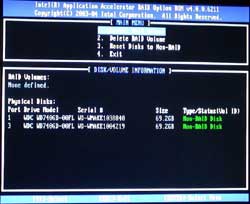 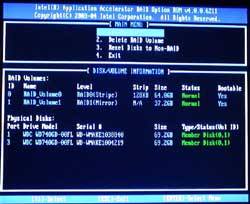
That however is not all what the new ICH6-R has to offer when it comes to hard disk usage. It’s also the first time that 4 native SATA channels are available, finally allowing us to run the same number of devices as before with 2 IDE/ATA ports in master and slave configuration on older motherboards. With 4 SATA channels the ICH6-R also allows us to take full advantage of RAID 0 with 4 SATA hard disks. Previously 4 SATA disks could only be run with a PCI based RAID controller. When using high-end hard disks like the “Raptor” WD740 with a PCI based controller, 2 of them could saturate the 133 MB/sec bandwidth the PCI bus provides. Therefore there was no gain in transfer rates when adding another 2 to run a RAID 0 array with 4 disks. However, the maximum bandwidth between the ICH6-R and the memory controller is 2 GB/sec. This is more than required for 4 SATA hard disks with a maximum of 150 MB/sec each.
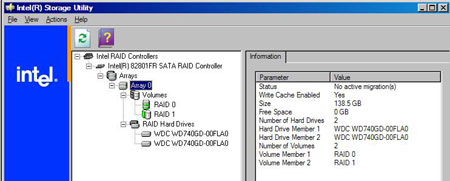
A Matrix RAID array by the way can only be set up with 2 hard disks - no more and no less. If 4 SATA hard disks are available, 2 independent Matrix RAID 0+1 volumes can be arranged. In order to show RAID 0 with 4 hard disks we combined our 4 single Western Digital “Raptor” WD740GB with a striped Dynamic Disk volume under Windows XP Pro. This requires booting from a 5th hard disk, because it is not possible to install the operating system on a dynamic disk volume. Dynamic disk is not available with the Windows Home Edition. All tests were done with the operating system installed on a PATA Maxtor Diamond Plus 9 160 GB.
For testing hard disk performance with the new ICH6-R we used the “Hard Disk Test Suite” included in PCMark 2004 Pro. The suite comprises 4 tests with a total of 11 subtests:- The “Windows XP Start-up” test measures disk activities occurring at system start-up.
- The “File Copying” test contains disk activities from copying around 400 MB of files.
- The “Application Loading” test measures loading times for MS Word, Acrobate Reader, MS Media Player, Mozilla Internet Browser, and 3DMark 2001.
- The “General Hard Disk Usage” test contains disk activities from using several common applications like opening a Microsoft Word document, playing MP3 with Winamp and browsing the Internet using Microsoft Internet Explorer.
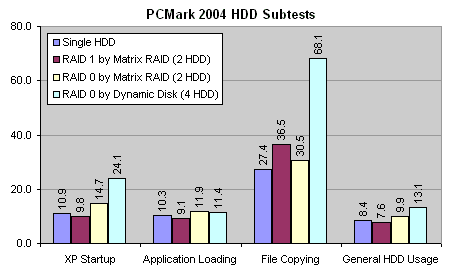
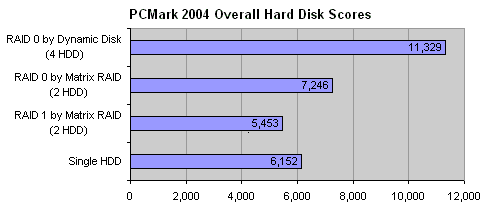
Our tests show that the RAID 1 array on the Matrix RAID volume is, with the exception of file copying, slower than a single hard disk. That is not surprising because all data on the RAID 1 array have to be duplicated between the 2 disk that make the array so that at any time a complete mirror is available. The beauty is that that the RAID 1 array remains fully operational even if one of the two hard disk drives fails. The RAID 0 array is faster performing than a single disk, in particular when loading Windows and applications. That is also not surprising because “striping” is supposed to do exactly this. The hard disk performance with RAID 0x2 however is dwarfed by the results with RAID 0x4. We have done a lot of hard disk testing with the fabulous “Raptor” hard disks - see here, here and here. However, we have never seen such skyrocketing results. In Winbench99 (not shown here) we achieved a sustained data transfer rate of almost 300 MB/sec for the RAID 0x4 arrays. This is due to all 4 drives enjoying the higher bandwidth available to the ICH6-R compared to the ICH5.
Our results demonstrate the benefits of the Matrix RAID: It becomes possible to enjoy RAID 0 performance and RAID 1 data redundancy with only 2 disks. That was not possible before. We will examine Intel’s Matrix RAID technology again soon in a more detailed, separate article.
|
|
Advertisement:
All original content copyright James Rolfe.
All rights reserved. No reproduction allowed without written permission.
Interested in advertising on OCAU? Contact us for info.
|

|


